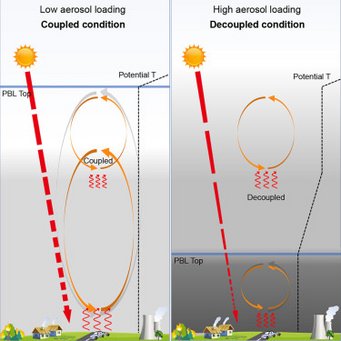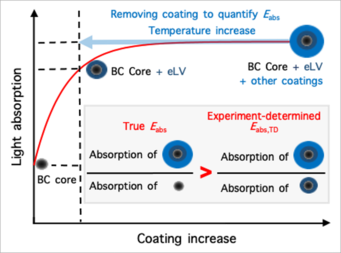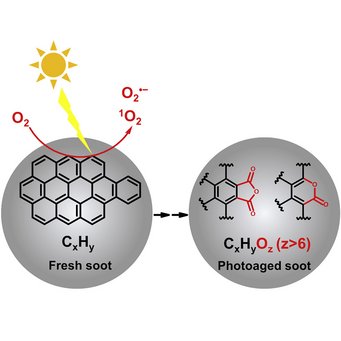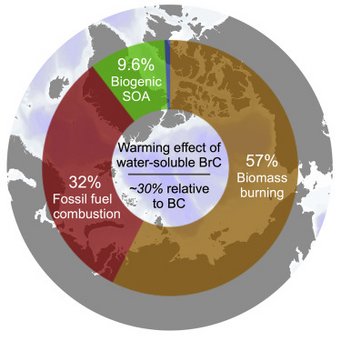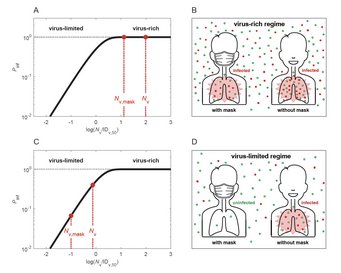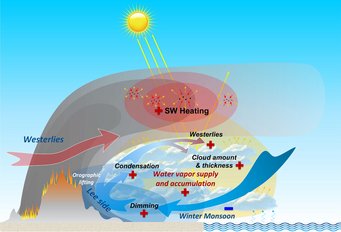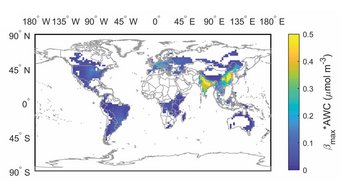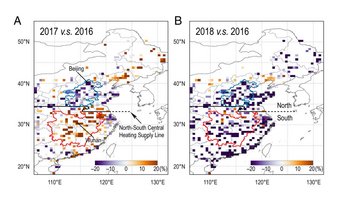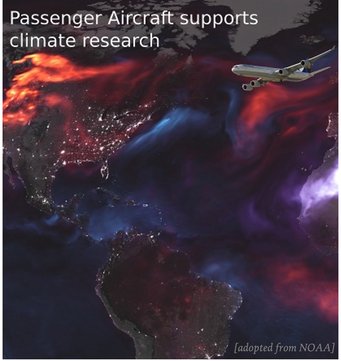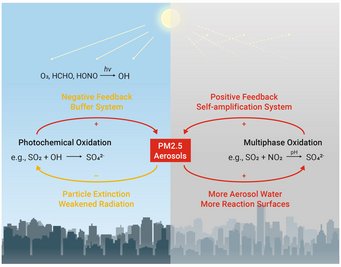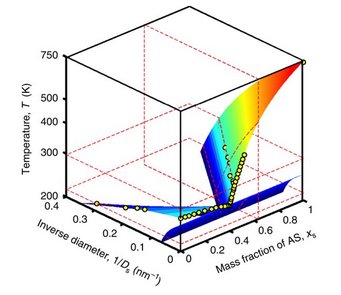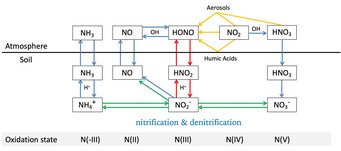Research highlights
High resolution mapping of aerosol pH in micropdroplets: Li et al., Spatial homogeneity of pH in aerosol microdroplets. Chem (Cell press) 2023.

Acidity plays a key role in atmospheric aerosol formation and strongly influences aerosols’ effects on air quality, climate, and the ecosystem. Fundamental questions about aerosol pH are, however, still under debate: how does the pH of aerosol microdroplets compare to that of the parent bulk solution, and do stable pH gradients exist within these microdroplets? Here, by using advanced single-particle and hyperspectral Raman microscopies, we directly measure the pH distribution in NaH2PO4-Na2HPO4 microdroplets (7–10 μm in radius) produced with the conjugate acid-base pair of H2PO4−-HPO42−. We show that the pH values of the investigated microdroplets are indistinguishable from the parent bulk solutions of the same electrolyte concentration and that the pH is essentially constant across the microdroplets, with standard deviations below 0.2 pH units. Similar results are observed for acidic NaHSO4 microdroplets. Our findings are essential to understanding atmospheric multiphase chemistry and overall reactions and processes occurring in aqueous microdroplets.
Black carbon aerosols can inhibit the development of the daytime planetary boundary layer (PBL) so significantly that it resembles nighttime conditions: Wang et al., Black-carbon-induced regime transition of boundary layer development strongly amplifies severe haze. One Earth (Cell press) 2023.
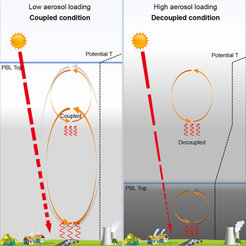
Air pollution is a major threat to human health. Severe haze is often caused by an unexpected extremely shallow planetary boundary layer (PBL), the lowest part of the atmosphere where most pollutants are concentrated. Insufficient understanding of the formation mechanism of a shallow PBL leads to failure of air quality forecast and effective prevention. We found that high atmospheric concentrations of black-carbon (BC) particles (an aerosol) can trigger a “prompt change” in PBL height. Above this tipping point, high concentrations of these particles suppress vertical mixing of atmospheric layers and create a stable PBL, trapping pollutants near the ground and greatly deteriorating air quality. This scenario can be avoided through targeted reductions of BC emissions (rather than targeting total particulate matter reductions). Results further show that mega-wildfires through climate change and nuclear disasters can result in enormous BC emissions and cause extreme stratification of the atmosphere and persistent aerosol layers.
Reconcile Debate on BC’s Climate Forcing: Zhang et al., Extremely low-volatility organic coating leads to underestimation of black carbon climate impact. One Earth (Cell press) 2023.

Challenge:
- BC particle coating/mixing with organics/inorganics expected to enhance light absorption and climate warming by factor ~2-3 according to theoretical predictions & lab studies (Jacobson Nature 2001, IPCC, 2014)
- Thermal treatment to remove coating of ambient particles indicates much smaller effect (<10%), which would lead to much less warming by BC (Cappa et al. Science 2012, IPCC, 2021): discrepancies unresolved
Breakthrough:
- New experimental approach combining single soot particle photometer (SP2) with volatility differential mobility analyzer, optical measurements and mass spectrometry shows that BC coatings by extremely low-volatile organics (eLV, 5-100%) persist after thermal treatment
- eLV coatings resolve earlier discrepancies and confirm strong warming by atmospherically aged and coated/mixed BC
Black carbon (BC) particles come from various incomplete combustions. It can strongly absorb solar radiation and is one of the most important short-lived climate warming agents. In the atmosphere, BC particles become coated via condensation, coagulation, and multiphase reactions. The coatings may greatly enhance BC’s light absorbing efficiency through the so-called “lensing effect,” thereby amplifying its climate warming effect. However, such “lensing effect” was found to be much weaker on BC in ambient air than predicted by theory and lab studies, leading to intensive debate about the actual extent of the coating-induced enhancement of its light absorption and climate impact. We find that this inconsistency arises from the widespread presence of extremely low-volatility (eLV) organics that coat BC. When eLV coatings are quantified and accounted, field observations and theoretical predictions reconcile, showing that coating effects could indeed enhance BC’s climate warming by up to ∼200%.
Particle phase chemistry enables soot to better seed clouds: Li et al., Highly oxygenated organic molecules with high unsaturation formed upon photochemical aging of soot. Chem (Cell press) 2022.
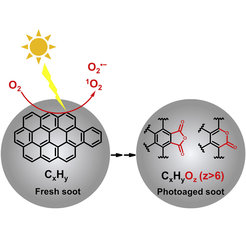
Organic aerosol (OA) is a major component of fine particulate matter in the atmosphere and strongly influences air quality, climate, and human health. However, the formation mechanism of OA is not yet well understood. The oxidation of gas-phase precursors has been considered as the major chemical pathway of OA formation in the atmosphere. We show that particle-phase photochemical oxidation of polycyclic aromatic hydrocarbons on soot can produce a substantial amount of highly oxygenated OA, which changes soot from being hydrophobic to being hydrophilic and increases the ability of soot particles to serve as cloud condensation nuclei. Our finding challenges the current understanding of the formation mechanism of atmospheric secondary organic aerosol and demonstrates a strong impact of particle-phase chemistry on the fate and climate effect of soot and combustion-related organic aerosols (e.g., from wildfires and fossil fuel combustions).
Intensified wildfires in a warming climate threatens the Arctic: Yue et al., Brown carbon from biomass burning imposes strong circum-Arctic warming. One Earth (Cell press) 2022.
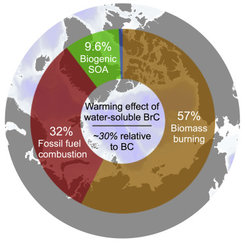
Rapid Arctic warming and associated glacier and sea ice melt have a great impact on the global environment, with implications for global temperature rise and weather patterns, shipping routes, local biodiversity, and methane release. Greenhouse gases and black carbon aerosols are well-known warming agents that accumulate in the Arctic atmosphere, but full warming agent picture remains incomplete, preventing accurate forecasts. The effects of brown carbon—an aerosol derived from biomass and fossil fuel burning—are particularly unclear. Through observations from a circum-Arctic cruise and numerical model simulations, we show that light-absorbing brown carbon, mainly from biomass burning, can impose a strong warming effect in the Arctic, especially in the summertime. If, as predicted, the frequency, intensity, and spread of wildfires continues to increase, this may reinforce circum-Arctic warming and further contribute to global warming, forming a positive feedback. In light of these results, the careful management of vegetation fires, especially in the mid- to high latitudes of the Northern Hemisphere, will prove important in mitigating the warming in the Arctic region.
MPIC news | BBC news | AltMetric Attention Score (>300)
Why and how masks work: Cheng et al., Face masks effectively limit the probability of SARS-CoV-2 transmission. Science 2021.

Airborne transmission by droplets and aerosols is important for the spread of viruses. Face masks are a well-established preventive measure, but their effectiveness for mitigating severe acute respiratory syndrome coronavirus 2 (SARS-CoV-2) transmission is still under debate. We show that variations in mask efficacy can be explained by different regimes of virus abundance and are related to population-average infection probability and reproduction number. For SARS-CoV-2, the viral load of infectious individuals can vary by orders of magnitude. We find that most environments and contacts are under conditions of low virus abundance (virus-limited), where surgical masks are effective at preventing virus spread. More-advanced masks and other protective equipment are required in potentially virus-rich indoor environments, including medical centers and hospitals. Masks are particularly effective in combination with other preventive measures like ventilation and distancing.
Falling Walls Science Breakthroughs of the year 2021 (Physical Sciences) | WoS "hot paper" & "hightly cited paper"|AltMetric Attention Score (>9500), placing it within the top 0.001% of over 22 million scientific papers published in total and ranked top 10 of over 77 thousands publications in Science | MPG news | MPIC news | EGU blog | Featured by Bloomberg | Further resources - COVID-19 Aeroosl Transmision Risk Calculator
Biomass burning aerosol-PBL-monsoon interactions modify low clouds: Ding et al., Aerosol-boundary-layer-monsoon interactions amplify semi-direct effect of biomass smoke on low cloud formation in Southeast Asia. Nature Communications 2021.

Low clouds play a key role in the Earth-atmosphere energy balance and influence agricultural production and solar-power generation. Smoke aloft has been found to enhance marine stratocumulus through aerosol-cloud interactions, but its role in regions with strong human activities and complex monsoon circulation remains unclear. Here we show that biomass burning aerosols aloft strongly increase the low cloud coverage over both land and ocean in subtropical southeastern Asia. The degree of this enhancement and its spatial extent are comparable to that in the Southeast Atlantic, even though the total biomass burning emissions in Southeast Asia are only one-fifth of those in Southern Africa. We find that a synergetic effect of aerosol-cloud-boundary layer interaction with the monsoon is the main reason for the strong semi-direct effect and enhanced low cloud formation in southeastern Asia.
Aerosol pH buffered by ammonia: Zheng et al., Multiphase buffer theory explains contrasts in atmospheric aerosol acidity. Science 2020.

Aerosol acidity largely regulates the chemistry of atmospheric particles, and resolving the drivers of aerosol pH is key to understanding their environmental effects. We find that an individual buffering agent can adopt different buffer pH values in aerosols and that aerosol pH levels in populated continental regions are widely buffered by the conjugate acid-base pair NH4+/NH3 (ammonium/ammonia). We propose a multiphase buffer theory to explain these large shifts of buffer pH, and we show that aerosol water content and mass concentration play a more important role in determining aerosol pH in ammonia-buffered regions than variations in particle chemical composition. Our results imply that aerosol pH and atmospheric multiphase chemistry are strongly affected by the pervasive human influence on ammonia emissions and the nitrogen cycle in the Anthropocene.
MPIC news | WoS "hot paper" and "highly cited paper" | Related studies - Zheng et al, ACP 2022; Zheng et al. ACS Environ. Au 2022
Importance and necessity of synergy between environmental and energy policymaking: Wang et al., Natural gas shortage during the "coal-to-gas" transition in China have caused a large redistribution of air pollution in winter 2017, PNAS 2020.
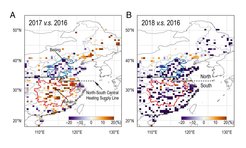
Improving air quality is an important driving force for China’s move toward clean energy and the extensive implementation of the “coal-to-gas” policy. Our analysis shows, however, that a shortage of natural gas during the implementation of the action in northern China has led to the transfer of pollution emissions and deterioration of air quality for large areas and populations in southern China during winter 2017. Our finding highlights the importance and necessity of synergy between environmental and energy policymaking to address the grand challenge of an actionable future to achieve the cobenefits of air quality, human health, and climate.
Passenger aircraft support climate research: Ditas et al., Strong impact of wildfires on the abundance and aging of black carbon in the lowermost stratosphere. PNAS 2018.
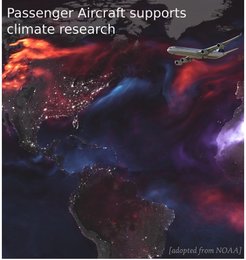
Unique information about the abundance and evolution of wildfire-emitted black carbon (BC) in the lowermost part of the stratosphere (LMS) was obtained from long-term airborne measurements made in cooperation with Lufthansa through the Civil Aircraft for the Regular Investigation of the atmosphere Based on an Instrument Container (CARIBIC) project, part of the In-service Aircraft for a Global Observing System (IAGOS) framework. Our results demonstrate that wildfires can dramatically increase BC mass concentration in the LMS, substantially enhance regional climate forcing, and are a challenge for model simulations. Climate change is expected to increase the frequency and spread of wildfires. Thus, recording a present-day baseline with extensive and long-term measurements should help to constrain model estimations of the climate impact of BC and foster our fundamental understanding of future climate change.
Phase state controls the fate of organic aerosols in the atmosphere: Mu et al., Temperature effect on phase state and reactivity controls atmospheric multiphase chemistry and transport of PAHs. Science Advances 2018.

Polycyclic aromatic hydrocarbons like benzo(a)pyrene (BaP) in atmospheric particulate matter pose a threat to human health because of their high carcinogenicity. In the atmosphere, BaP is mainly degraded through a multiphase reaction with ozone, but the fate and atmospheric transport of BaP are poorly characterized. Earlier modeling studies used reaction rate coefficients determined in laboratory experiments at room temperature, which may overestimate/underestimate degradation rates when applied under atmospheric conditions. Moreover, the effects of diffusion on the particle bulk are not well constrained, leading to large discrepancies between model results and observations. We show how regional and global distributions and transport of BaP can be explained by a new kinetic scheme that provides a realistic description of the temperature and humidity dependence of phase state, diffusivity, and reactivity of BaP-containing particles. Low temperature and humidity can substantially increase the lifetime of BaP and enhance its atmospheric dispersion through both the planetary boundary layer and the free troposphere. The new scheme greatly improves the performance of multiscale models, leading to better agreement with observed BaP concentrations in both source regions and remote regions (Arctic), which cannot be achieved by less-elaborate degradation schemes (deviations by multiple orders of magnitude). Our results highlight the importance of considering temperature and humidity effects on both the phase state of aerosol particles and the chemical reactivity of particulate air pollutants.
Aquesous phase chemistry in aerosol water plays important role in haze formation: Cheng and Zheng et al., Reactive nitrogen chemistry in aerosol water as a source of sulfate during haze events in China. Science Advances 2016.

Fine-particle pollution associated with winter haze threatens the health of more than 400 million people in the North China Plain. Sulfate is a major component of fine haze particles. Record sulfate concentrations of up to ~300 μg m−3 were observed during the January 2013 winter haze event in Beijing. State-of-the-art air quality models that rely on sulfate production mechanisms requiring photochemical oxidants cannot predict these high levels because of the weak photochemistry activity during haze events. We find that the missing source of sulfate and particulate matter can be explained by reactive nitrogen chemistry in aerosol water. The aerosol water serves as a reactor, where the alkaline aerosol components trap SO2, which is oxidized by NO2 to form sulfate, whereby high reaction rates are sustained by the high neutralizing capacity of the atmosphere in northern China. This mechanism is self-amplifying because higher aerosol mass concentration corresponds to higher aerosol water content, leading to faster sulfate production and more severe haze pollution.
MPIC news | Seeker news | WoS "hot paper" & "hightly cited paper" | AltMatric Attention Score > 100 | Related study - Tao et al., ACP 2020 | Related study - Zheng et al., Exploring the severe winter haze in Beijing: the impact of synoptic weather, regional transport and heterogeneous reactions. Atmos. Chem. Phys., 2015. ("Hot paper (top 0.1%)" in Web of Science & the 2nd most cited paper in ACP in the five years of 2015-2019) | Impact on policy making (Top News from the State Council of P.R. China & Chen, Jining's Answers to Reporters' Questions at the Press Conference of the Fifth Session of the Twelfth National People's Congress)
New 3D phase diagram: Cheng et al., Size dependence of phase transitions in aerosol nanoparticles. Nature Communications 2015.

Phase transitions of nanoparticles are of fundamental importance in atmospheric sciences, but current understanding is insufficient to explain observations at the nano-scale. In particular, discrepancies exist between observations and model predictions of deliquescence and efflorescence transitions and the hygroscopic growth of salt nanoparticles. Here we show that these discrepancies can be resolved by consideration of particle size effects with consistent thermodynamic data. We present a new method for the determination of water and solute activities and interfacial energies in highly supersaturated aqueous solution droplets (Differential Köhler Analysis). Our analysis reveals that particle size can strongly alter the characteristic concentration of phase separation in mixed systems, resembling the influence of temperature. Owing to similar effects, atmospheric secondary organic aerosol particles at room temperature are expected to be always liquid at diameters below ~20 nm. We thus propose and demonstrate that particle size should be included as an additional dimension in the equilibrium phase diagram of aerosol nanoparticles.
Soil-atmosphere interactions influence atmospheric chemistry: Su and Cheng et al., Soil Nitrite as a Source of Atmospheric HONO and OH Radicals. Science 2011.

Hydroxyl radicals (OH) are a key species in atmospheric photochemistry. In the lower atmosphere, up to ~30% of the primary OH radical production is attributed to the photolysis of nitrous acid (HONO), and field observations suggest a large missing source of HONO. We show that soil nitrite can release HONO and explain the reported strength and diurnal variation of the missing source. Fertilized soils with low pH appear to be particularly strong sources of HONO and OH. Thus, agricultural activities and land-use changes may strongly influence the oxidizing capacity of the atmosphere. Because of the widespread occurrence of nitrite-producing microbes, the release of HONO from soil may also be important in natural environments, including forests and boreal regions.

